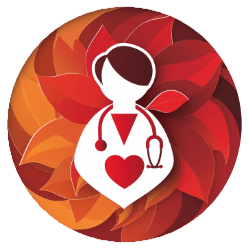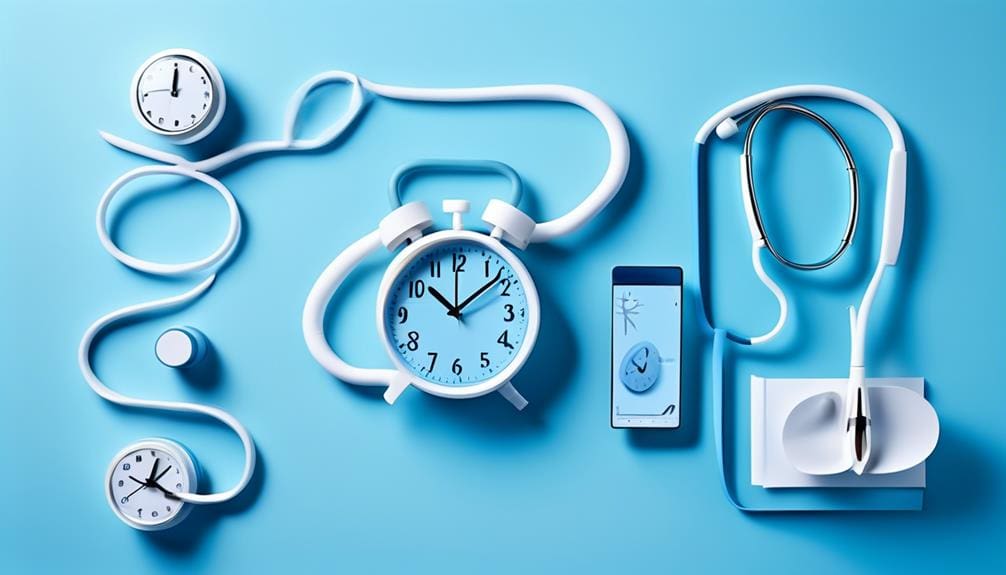Imagine you’re walking through a serene park, the sounds of nature offering a soothing background track, far removed from the relentless pings and buzzes of your devices.
Now, consider this tranquility as not just a fleeting escape but a vital part of your daily routine, especially if you’re a healthcare worker. You’re on the front lines, constantly connected, not just to your work but also to an incessant stream of information and communication.
It’s undeniable that this digital tether can take its toll, leading to burnout, stress, and a host of other issues. Crafting a tech break plan isn’t just a luxury; it’s a necessity for your mental and physical well-being.
By setting realistic goals and identifying tech-free zones, you can begin to reclaim some of your time and attention from the digital grasp. But how do you start, and what strategies will truly make a difference without compromising the demands of your critical role?
Let’s explore together how you can effectively unplug, even if just for moments at a time, to foster closer relationships, enhance your focus, and significantly reduce stress.
Key Takeaways
- Excessive use of technology can lead to digital fatigue, which is a blend of mental and physical exhaustion.
- A technology detox can alleviate stress and anxiety, allowing healthcare workers to refocus on what truly matters.
- Creating tech-free zones at home and work can help manage the relationship with technology and promote a healthier work-life balance.
- Regularly monitoring progress and adjusting strategies accordingly is crucial for effective digital management and overall well-being.
Understanding Digital Fatigue
In today’s digital age, it’s easy to overlook how the constant buzz of our devices can lead to digital fatigue, impacting both your mind and body. As you dedicate yourself to serving others, it’s crucial to recognize the toll that prolonged exposure to screens, especially through social media, can take on your well-being. Digital fatigue isn’t just about being tired; it’s a blend of mental and physical exhaustion stemming from excessive use of technology.
This fatigue can manifest in several ways, including eye strain, headaches, and difficulty focusing. You might find your sleep disrupted, which, in turn, affects your ability to care for others effectively. The incessant stream of information can also lead to burnout, making it harder for you to stay productive and present in your work and personal life.
Fortunately, there are strategies to combat this fatigue. Establishing boundaries around your digital device usage, taking regular tech breaks, and practicing mindfulness aren’t just acts of self-care; they’re essential for maintaining your ability to serve others compassionately and effectively.
The Need for Detox
Why not consider a technology detox to alleviate the stress and anxiety that come from being constantly connected? Taking a step back from your devices can help you refocus on what truly matters, offering you a chance to recharge your mental and physical batteries. It’s about spending time in the present moment, enhancing your mindfulness, and reconnecting with yourself and those around you.
Here’s how a tech detox can benefit you:
| Benefit | Description | Impact on Life |
|---|---|---|
| Reduced Stress | Less screen time means lower anxiety levels. | More peaceful daily living. |
| Improved Relationships | Spending time away from screens enhances connections. | Deeper, more meaningful interactions. |
| Increased Productivity | Detoxing leads to better focus and efficiency. | Accomplish more with less effort. |
| Enhanced Self-Worth | Rediscover interests and hobbies outside tech. | Feel more fulfilled and valued. |
Setting Realistic Goals
After recognizing the benefits of a tech detox, it’s essential to establish realistic goals to ensure you’re setting yourself up for success. As health care workers, your dedication to serving others is unparalleled, but it’s equally important to serve yourself by managing your relationship with technology.
Begin with achievable objectives that resonate with your capabilities and resources. This approach ensures you’re not setting yourself up for failure right from the start.
Break down these larger goals into smaller, manageable tasks. This strategy allows you to track your progress effectively and adjust your plan as needed.
Adopting specific, measurable, attainable, relevant, and time-bound (SMART) goals will help maintain your focus and direction. Regularly assess and adjust these goals to reflect your evolving circumstances and the feedback you receive.
Identifying Tech-Free Zones
Creating tech-free zones, whether at home or work, is a crucial step toward maintaining your mental well-being and fostering genuine connections. In the demanding world of healthcare, where technology is a constant companion, finding moments to disconnect can rejuvenate your spirit and enhance your capacity to care for others.
Designate specific rooms or areas in your home or workplace as tech-free zones. For instance, establishing a gadget-free bedroom can significantly improve your sleep quality and relaxation, freeing you from digital distractions that can impede restorative rest. Similarly, consider creating a tech-free zone during meals or family time. This practice encourages meaningful interactions and conversations, allowing you to connect on a deeper level with those around you.
Implementing a no-technology policy during designated relaxation or mindfulness activities is another effective way to disconnect and recharge. These moments of disconnection foster a deeper sense of presence and mindfulness, critical for your mental health.
Moreover, identifying specific outdoor areas, such as parks or nature spots, where technology is off-limits can help you fully immerse yourself in the natural world. This immersion can provide a refreshing break from the constant engagement with healthcare technology, offering you a much-needed respite to recharge and refocus.
Scheduling Offline Activities
Once you’ve identified your tech-free zones, it’s time to fill them with activities that rejuvenate your spirit.
Consider selecting hobbies that relax you or planning escapes into nature as essential parts of your schedule.
These moments away from screens are your chance to recharge, so treat them as sacred.
Selecting Relaxing Hobbies
To ensure your well-being, selecting hobbies that allow you to disconnect and recharge is crucial. These activities shouldn’t only be enjoyable but also serve to enhance your mental health. Consider hobbies that foster creativity, such as painting or drawing, writing poetry or stories, and crafting, such as knitting or woodworking.
Additionally, hobbies that encourage physical activity can be beneficial for your mental health. Examples of these activities include hiking in nature, practicing yoga or meditation, and engaging in gardening or urban farming.
Furthermore, promoting relaxation is another important aspect of choosing hobbies. Reading fiction or non-fiction, listening to music or playing an instrument, and cooking or baking for pleasure can all contribute to a sense of relaxation and well-being.
Planning Nature Escapes
Building on the importance of selecting relaxing hobbies, planning nature escapes offers a powerful way to deepen your offline activities and enhance your overall well-being. By immersing yourself in the outdoors, you’re not just disconnecting from technology; you’re connecting with an environment that has profound health impacts.
Blocking off time for activities away from screens allows you to engage in physical activities, like outdoor workouts or walks, in natural settings. This not only boosts your mental wellness through disconnection but also encourages you to create tech-free zones, be it at home or work, dedicated to offline relaxation and leisure.
Managing Notifications Wisely
Transitioning smoothly from scheduling offline activities, let’s now focus on how you can manage notifications effectively.
By prioritizing urgent alerts, scheduling times to check non-essential notifications, and wisely utilizing silent modes, you’ll create a more balanced and less intrusive digital environment.
These strategies are essential in ensuring you’re not constantly pulled away from your important work or much-needed rest.
Prioritize Urgent Alerts
In the fast-paced world of healthcare, effectively managing urgent alerts and notifications can significantly reduce stress and enhance your focus on patient care. Research shows that a structured approach to handling these alerts can make a world of difference.
Here’s how you can prioritize:
- Set specific times for urgent alerts
- Consolidate notifications for efficiency
- Filter and categorize for quick attention
- Establish clear boundaries to maintain focus
Creating filters and rules helps ensure that you’re only alerted to what truly matters. Utilizing technology tools can streamline this process, allowing you to maintain your dedication to serving others without becoming overwhelmed. Regularly updating your settings guarantees that this system remains effective, keeping your attention where it’s needed most.
Schedule Non-Essential Notifications
After establishing a solid foundation for managing urgent alerts, it’s equally important to address how you handle non-essential notifications during your busy day.
In the selfless pursuit of serving others, minimizing distractions is crucial. Silencing non-essential notifications can help you maintain focus and productivity. Use ‘Do Not Disturb’ mode or customize your settings to reduce unnecessary interruptions, allowing you to spend time more wisely.
Designate specific times to check these notifications to avoid constant disruptions. Consider turning them off during designated tech breaks to fully disconnect and recharge.
Utilize Silent Modes Wisely
Understanding the importance of managing notifications can significantly reduce distractions, allowing you to focus more during tech breaks. By utilizing silent modes and don’t disturb settings, you create necessary boundaries that help manage interruptions effectively. This is crucial for your mental well-being and productivity, especially in a profession dedicated to serving others.
- Utilizing silent modes wisely can help:
- Reduce stress levels: Fewer interruptions mean less stress.
- Prioritize essential notifications: Filter what you really need to take immediately.
- Increase productivity: Focus without constant pings.
- Promote mindfulness: Engage more fully in your break time.
Recognize the significance of these practices in maintaining a healthy balance and reducing anxiety. Making these small changes is a step toward a more mindful and focused you.
Encouraging Peer Support
Fostering a culture of open communication and trust among colleagues is crucial for effective peer support in healthcare settings. In a profession where the demands can be as high as the stakes, knowing you’ve got the support of your peers isn’t just comforting; it’s essential. This isn’t about grand gestures, but the everyday moments of understanding and shared experiences that build a foundation of mutual respect and care.
By providing opportunities for peer-mentoring programs and group debriefing sessions, you encourage a sense of community. These platforms allow you to share knowledge, experiences, and even the weight of difficult days, making the burdens of healthcare work lighter for everyone. Remember, the World Health Organization emphasizes the importance of mental health in the medical profession, and peer support is a key component of that.
Acknowledging and celebrating small wins and achievements within your team boosts morale and reinforces the value of every team member’s contributions. Encouraging peer support networks and forums fosters a space where you can seek advice, share experiences, or simply find an understanding ear. Offering training on active listening and empathetic communication further enhances these support systems, ensuring that when you reach out, you’re met with compassion and understanding.
Embracing Mindfulness Practices
As you navigate the demands of your healthcare role, consider integrating mindful breathing techniques into your daily routine. These practices can significantly reduce stress, improving your focus and enabling you to remain present with your patients and colleagues.
Additionally, dedicating time to daily meditation can enhance your emotional resilience, allowing you to find a sense of balance in your challenging work environment.
Mindful Breathing Techniques
Healthcare workers can significantly benefit from adopting mindful breathing techniques, a practice that fosters calm and focus amidst their demanding routines. When you’re constantly on the move, caring for others, and faced with situations that require your immediate attention and the need to think critically, it’s crucial to find ways to ground yourself.
Mindful breathing can:
- Reduce stress and anxiety, making it easier to approach your tasks with a clear mind.
- Enhance self-awareness and emotional regulation, helping you respond more effectively to the needs of your patients.
- Promote relaxation and reduce tension in the body, ensuring you’re physically ready for the challenges ahead.
Incorporating these practices into your daily routine can transform how you experience your work, allowing you to serve with greater presence and compassion.
Daily Meditation Benefits
By incorporating daily meditation into your routine, you’ll discover a profound shift in your stress levels, focus, and overall emotional health. Just a few minutes per day devoted to mindfulness practices can significantly enhance your emotional well-being, leading to better self-awareness and mental clarity.
This simple yet powerful tool not only improves your physical health by boosting immune function and promoting better sleep but also aids in managing anxiety, depression, and chronic pain. By fostering a sense of calm and resilience, daily meditation cultivates a greater sense of compassion and empathy, essential qualities for anyone dedicated to serving others.
Embrace this practice to nurture your well-being, ensuring you can provide the best care with a refreshed and focused mind.
Monitoring Progress Regularly
Monitoring your progress regularly is crucial to understanding the true impact of taking technology breaks on your overall well-being and job performance. Studies have shown that setting specific, measurable goals and using tools like apps or trackers can significantly enhance your ability to manage your digital consumption effectively.
Implementing a tech break plan necessitates:
- Setting clear objectives: Whether it’s reducing screen time by an hour daily or ensuring your evenings are tech-free, having clear goals is your roadmap.
- Utilizing Tracking Tools: Apps and trackers aren’t just for steps or calories; they’re invaluable for monitoring your digital diet.
Assessing Impact:
- Mental Well-being: Regularly evaluate how these breaks are affecting your stress levels and mental peace.
- Productivity: Notice any changes in your work output and efficiency.
- Overall Health: Reflect on any physical improvements or enhancements in your sleep quality.
Adjusting Strategies Accordingly
After establishing your tech break goals and tracking your progress, it’s crucial to assess and fine-tune your strategies to meet your unique needs effectively. This means being flexible and open to experimenting with different approaches until you find what truly works for you.
In the demanding world of healthcare, where your priority is serving others, it’s vital to also serve yourself by adjusting strategies accordingly. This means being flexible and open to experimenting with different approaches until you find what truly works for you.
As you monitor your progress, don’t hesitate to solve a problem by tweaking your plan. Whether it’s the length of your tech breaks or the activities you choose to engage in during these times, remember, there’s no one-size-fits-all solution.
External factors, such as work demands or personal commitments, may also necessitate adjustments to your tech break strategies.
Most importantly, always listen to your mental and emotional well-being. If a particular strategy isn’t serving you as hoped, be willing to modify it. This responsive approach ensures that your tech break plan supports your overall health, allowing you to continue providing the best care to others.
Frequently Asked Questions
How Do I Break Into Tech From Healthcare?
To pivot into tech, leverage your healthcare skills like decision-making and communication. Explore roles like AI engineer or IT administrator. Prepare by choosing a specialization, seeking technical training, and crafting a tech portfolio.
How Technology Has Impacted the Healthcare Industry?
Technology’s reshaped healthcare by improving patient care, enabling remote access, and enhancing diagnostics with AI. It empowers you to take health into your own hands and find supportive communities online. It’s truly transformative.
What Are Ethical Implications Related to Technology Access in Health Care Today What Issues in This Area Do You Anticipate That We Will See in the Future?
Navigating tech’s ethical maze, you face privacy and security challenges today, ensuring data safety. Tomorrow, you’ll wrestle with equitable tech access and its impact on patient care, seeking to balance innovation with compassion.
How Has AI Impacted Healthcare?
AI’s significantly improved healthcare, from boosting diagnostic accuracy to offering 24/7 patient support through chatbots. It’s enabling personalized care and reducing hospital stays, making your efforts in healthcare more effective and impactful.





